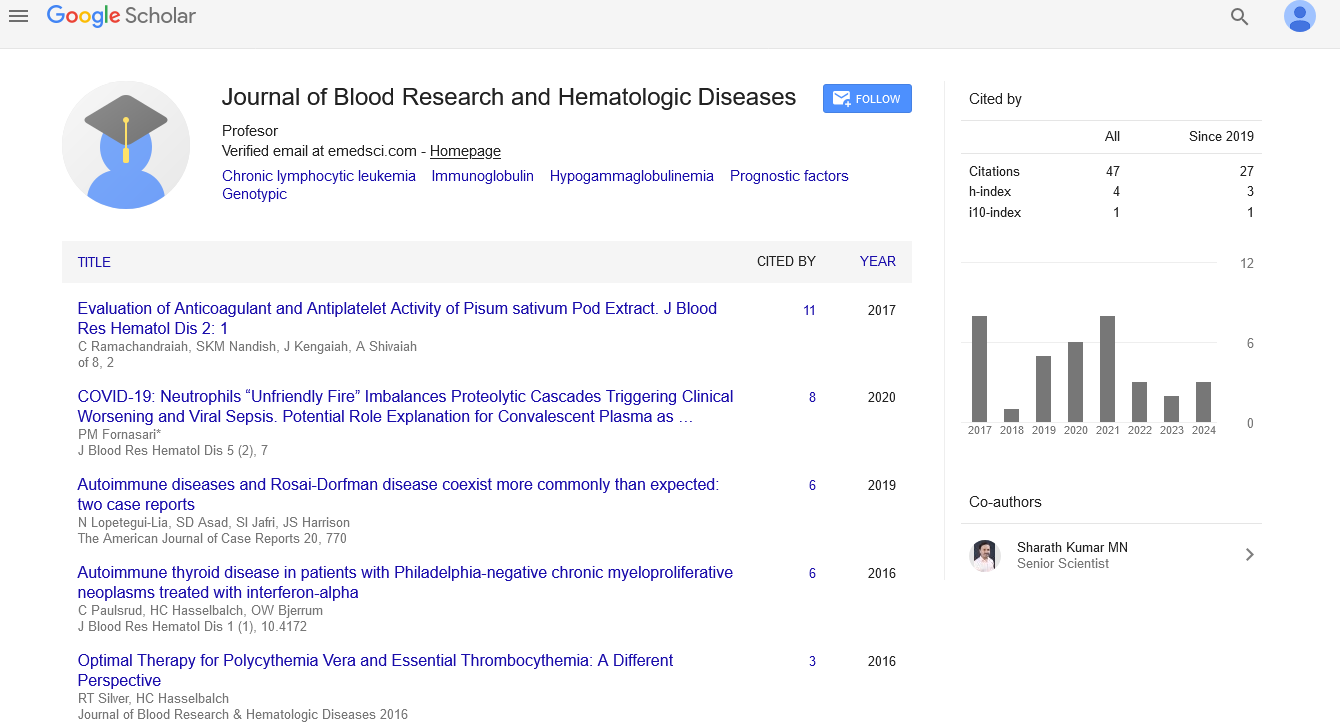Commentary, J Blood Res Hematol Dis Vol: 10 Issue: 1
An In-Depth Look at Blood Composition: Plasma and Tissue Volume Analysis
Tohwarz Mereaot*
Department of Medical Oncology, University of Ottawa, Ontario, Canada
*Corresponding Author:Tohwarz Mereaot
Department of Medical Oncology, University of Ottawa, Ontario, Canada
E-mail:tohwarzmere@gmail.com
Received date: 24 May, 2024, Manuscript No. JBRHD-24-137146;
Editor assigned date: 27 May, 2024, PreQC No. JBRHD-24-137146(PQ);
Reviewed date: 11 June, 2024, QC No. JBRHD-24-137146;
Revised date: 10 March, 2025, Manuscript No. JBRHD-24-137146(R);
Published date: 17 March, 2025, DOI: 10.4172/jbrhd.1000220
Citation: Mereaot T (2025) An In-Depth Look at Blood Composition: Plasma and Tissue Volume Analysis. J Blood Res Hematol Dis 10:1.
Description
Blood, the lifeline of the human body, is a complex fluid that performs vital functions essential for our health and survival. Composed of various components, blood's composition is carefully balanced to ensure optimal physiological function. In this article, we delve into the intricate details of blood composition, focusing specifically on plasma and tissue volume analysis.
Understanding blood composition
Blood is primarily composed of two main components: Plasma and cellular elements. Plasma, the liquid portion of blood, accounts for approximately 55% of its total volume. The remaining 45% consists of cellular components, including red blood cells, white blood cells, and platelets. Each component plays a crucial role in maintaining homeostasis and supporting bodily functions.
Plasma: The fluid matrix
Plasma is a clear, straw-colored fluid that serves as the medium through which blood cells and other substances are transported throughout the body. It is composed of approximately 90% water, making it an essential carrier of nutrients, hormones, electrolytes, and waste products. Additionally, plasma contains proteins such as albumin, globulins, and fibrinogen, which contribute to maintaining osmotic balance, immune function, and blood clotting mechanisms.
Cellular components: Red blood cells, white blood cells, and platelets.
The cellular components of blood are suspended in plasma and perform specialized functions crucial for overall health:
Red blood cells (Erythrocytes): Red blood cells are responsible for transporting oxygen from the lungs to tissues throughout the body and carrying carbon dioxide back to the lungs for elimination. Their unique structure, including hemoglobin molecules, enables efficient gas exchange essential for cellular metabolism.
White blood cells (Leukocytes): White blood cells are key players in the body's immune response, defending against infections and foreign invaders. They exist in several types, each with specific roles in recognizing and neutralizing pathogens, producing antibodies, and regulating immune responses.
Platelets (Thrombocytes): Platelets are essential for blood clotting (hemostasis) and wound healing. They adhere to damaged blood vessel walls, aggregate to form clots, and release substances that promote clotting and tissue repair.
Clinical significance of plasma and tissue volume analysis
Understanding the distribution and composition of plasma and cellular components is crucial in clinical settings for several reasons:
Diagnostic tests: Blood tests, such as Complete Blood Count (CBC) and blood chemistry panels, analyze plasma and cellular components to assess overall health, detect abnormalities, and monitor disease progression.
Transfusion medicine: Knowledge of blood composition guides blood transfusion practices, ensuring compatibility between donor and recipient and minimizing the risk of adverse reactions.
Research and treatment: Research involving blood composition informs advancements in medical treatments, such as therapies for blood disorders, cancer treatments, and understanding metabolic diseases.
Challenges and advances
Despite advances in understanding blood composition, challenges remain, including maintaining a stable blood supply, addressing bloodrelated disorders, and ensuring the safety of blood products. Ongoing research aims to optimize blood transfusion practices, develop new therapies, and enhance diagnostic capabilities.
Conclusion
In conclusion, blood composition, characterized by its plasma and cellular components, is integral to maintaining physiological balance and supporting essential bodily functions. Plasma serves as the fluid matrix that transports nutrients and wastes, while cellular elements, including red blood cells, white blood cells, and platelets, perform specialized roles critical for health and immunity. By exploring the intricacies of blood composition through plasma and tissue volume analysis, we gain deeper insights into its clinical significance and the ongoing pursuit of advancements in healthcare.
 Spanish
Spanish  Chinese
Chinese  Russian
Russian  German
German  French
French  Japanese
Japanese  Portuguese
Portuguese  Hindi
Hindi 